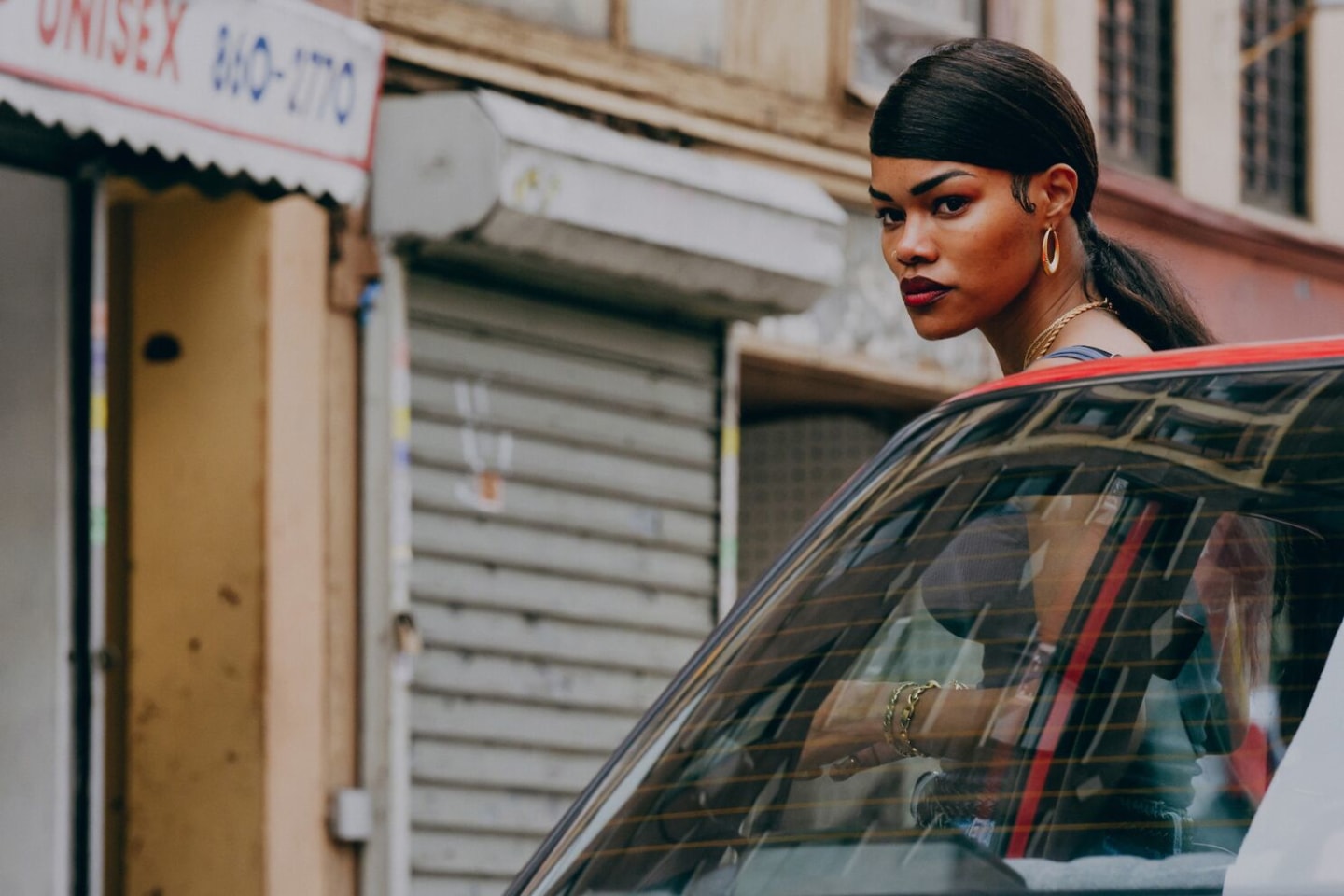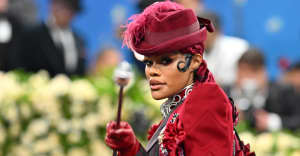 Teyana Taylor in A Thousand And One.
Aaron Ricketts/Focus/TNS
Teyana Taylor in A Thousand And One.
Aaron Ricketts/Focus/TNS
A Thousand And One mixes its personal and political themes in ways that feel deeply intentional. A.V. Rockwell's feature-length directorial debut tells the story of a desperate young mother doing the best for her child in mid-90s Harlem, battling oppressive policing and hungry real estate developers along the way. Inez (Teyana Taylor, in a revelatory performance) fresh out of jail, essentially kidnaps six-year-old Terry from his foster home and continues to raise him herself. She's doing the wrong things for the right reasons, and the film gracefully avoids casting aspersions on her actions. In her first major dramatic role, Taylor establishes herself as a skilled dramatic actor as she portrays Inez’s efforts to protect her son as well as keep her secret under wraps. It is, in many ways, a tale of survival with big city life being portrayed as treacherous a landscape as any jungle or arctic tundra.
Rockwell, who also wrote the script, was raised in Jamaica, Queens, and pulls memories of the era’s systemic inequality and rising gentrification as context for the risky decisions Inez makes. The movie painfully depicts the trials of building a life in a system that is hostile towards your very existence, as Inez and her neighbors attempt to secure basic amenities like a stable home and regular income. Audio clips of Mayors Giuliani and Bloomberg mark the passage of time as the movie skips into the early 2000s and white couples begin visiting Inez’s apartment with a view to taking their place. Taylor bobs and weaves to keep a roof over her head and her son a part of her life. The movie's period setting feels pertinent to the modern day while also acting as a warning.
Speaking during a busy press day in her hometown New York, director Rockwell explained the personal side of the story she is telling in her movie, as well as taking the opportunity to lay yet more praise at the feet of Taylor, who is picking up Oscar buzz for her breakout role.
The FADER: Congratulations on the movie. How does it feel to see a film you directed in theaters? It must be a real landmark achievement.
A.V. Rockwell: It feels so magical and I'm so excited to see that the movie has been so well received. We launched it at Sundance and won the Grand Jury prize. That speaks to how people saw the same things that I see. I really wanted to honor people that felt invisible within society. And so it's one thing for me to see them, but for audiences and for the industry to see them too, I think is the best feeling.
When you say people who are invisible in society, who specifically did you write this film for and about?
I think in many ways it talks about just marginalized people in general. I think the community of Harlem specifically, and Black communities like Harlem within New York City, that just felt like they were targeted. One of the big things in the movie is gentrification, and it felt like we were just being erased and pushed out of the city altogether. And to see vulnerable populations, especially when you think of characters like Inez who have really fought across generations just to get a sense of stability and get the space they need to pursue and focus on the American dream, I think gentrification just knocks them down again. And I didn't want that to get forgotten amongst all the things that people celebrate when they think about how neighborhoods are "Proved, improved by gentrification."
I also really wanted to acknowledge inner-city Black women, I think in the way that they feel must be understood not only in society, but within our own communities. I really wanted to use this movie as my way of creating a love letter for them. And also using Inez' journey as the main character to explore the idea of who really is fighting for Black women like her because she spent so much of her journey fighting for everyone else. And I think it's really a testament to what the whole community goes through in that respect and wanting to fully be loved and not just needed, not just everyone's superhero.
The movie is built around this incredible Teyana Taylor performance. What was it in particular about her that made her Inez to you?
Initially I wasn't as receptive to the idea of her being considered for the role because I just didn't have a lot of examples of her previous acting experience. I just didn't have enough to see the range of what she could bring. And I felt like it's too cheesy and almost superficial to strongly consider her just because she's from Harlem. I think all of those are bonuses, and it was important to me, the authenticity of a New York City woman, but I know I also needed that, balanced with the pedigree and depth and talent of a really mesmerizing actress.
What ultimately happened is that she read for the role and really stood out as a gem. She showed me all of that, all that I wanted to see not only in what she could give as an actress, but also what she could give in truthfully representing this type of woman, this type of inner-city woman with a sense of compassion and empathy. It felt like she was right there with Inez.
When you are writing a character like Inez, or even just any of the women in your film, were there particular people from your past in mind while you were writing?
I think the energy and spirit of her really captures a community of women that I was thinking about. I was thinking about women in my family, women that I was raised around, my friends' moms, just so many women that have influenced me over my lifetime. I really wanted to celebrate them and dignify them. Because I think that they are just so diminished and devalued and demeaned in the way that people treat them and look at them, when they have so much of the world on their shoulders.
The movie is partly set in 2001 but doesn't mention 9/11, which obviously is a very big thing to drop into the background of this personal story. But was that something that you consciously decided to leave out? And if so, why?
It's so interesting that people are asking me about that now because when I was writing the movie, that was always a part of the story. I think the movie makes three big jumps, 94, which was a pivotal year, 2001 was a pivotal year. And in the movie, you see how it's the changing of the guard, and how that timeframe impacts the characters, especially the policies that ended Bloomberg's era and the ways the city was shifting. I think with 9/11, to me, just growing up in the city, I felt like I witnessed a spiritual change to the city. There was an energy change and obviously there were certain things that did change how we experienced the city altogether.
I really fought for it because I think sometimes when I was getting feedback on the movie, on the screenplay, people would make it seem like it was too much of a world event to speak of, and it wasn't a personal story for me as a New Yorker, and as a child who witnessed this and experienced this as a New York City kid.
And so I really fought for it up until the end, but unfortunately we just really didn't have the budget to honor it in the way that I wanted to and in the way that I wanted to show how that also would've impacted these characters' lives. And I felt like if I am going to bring it up, I need to do it the right way.
One of the most striking things about the movie is the cinematography. Were there movies that you cited as references while you were working with cinematographer Eric Yu and the rest of your team to say, "This is how New York looks to me."
What's interesting, I think if there was one movie reference that I think stood out, I think it was Carol because it was a period movie, but it was also very intimate. And I think I was also trying to be mindful of telling a period story on a very limited budget. And so I think that was something that I thought of and Eric and I specifically talked a lot about. But I think with the team collectively, bigger reference points for us was just really looking at documentation of New York City, whether that was in photography and also in documentaries. I sent them a lot of photo books.
Are there any particular books you'd like to point people towards?
Yeah, I love [Katsu Naito's] Once in Harlem. I think that was a really great reference point for us. Vanishing New York [Jeremiah Moss], too. NYC Storefronts by Joel Holland is a great photo book as well. Vanishing New York talks about how New York is losing its identity altogether, and what the continuity of New York looked like and versus what New York is becoming now, which is a very dramatic personality change, versus the city that we've known and come to love historically. That’s something I really wanted to get across with this movie, too.
If we were to program a screening of A Thousand and One with another movie that you feel pairs with it nicely, what would be that second movie and why?
Recently, just in all conversations that I've been having about the movie, it made me rethink one of my childhood favorite films, which was Who Framed Roger Rabbit. And I think that's actually a very wonderful companion piece, because I think had it not been for me making this movie and the deep dive it made me take into my experiences and into just how I understood New York period, how I understood how marginalized communities like the black community in New York City related to the city. If anybody knows anything about the history of New York and Robert Moses and figures like him, including the leaders in the A Thousand and One, you see how much people in power take for granted what it means to just knock these communities down and try to erase them completely. And what a devastating loss it is to lose them, and the price of that.
What I realize now is that both stories are about displacement and what that means for a community of people. It's also about cities and what makes them great, and cities are made of the people that give them that rich character. Who Framed Roger Rabbit is a story about Toontown and protecting what was so special about that place, which was the characters. Roger Rabbit wasn’t walking around Los Angeles, right?
